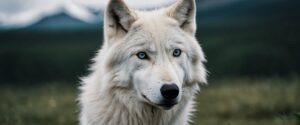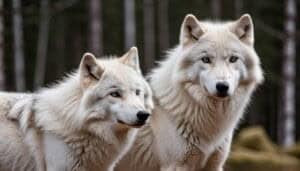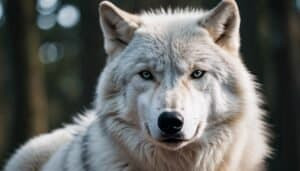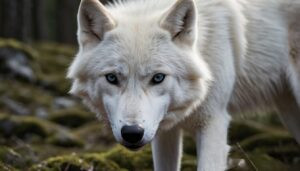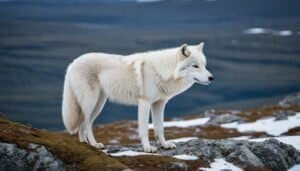Introduction
Arctic wolves face unique challenges due to their harsh environment, particularly the bright glare of snow. Their eyes have evolved remarkable adaptations to cope with these extreme conditions
This article will delve into the key features of Arctic wolves’ eyes, how they filter UV light, the impact of snow glare on their vision, and the evolutionary advantages these adaptations provide. We will also explore similar adaptations in other Arctic animals and review current research findings on Arctic wolves’ vision
Adaptations of Arctic Wolves’ Eyes
Arctic wolves, also known as Canis lupus arctos, have developed unique eye adaptations that allow them to thrive in the harsh, snowy environments of the Arctic
These adaptations help them deal with extreme light conditions, enabling them to hunt effectively and avoid dangers despite the intense glare from the snow
Key Features of Arctic Wolves’ Eyes
The eyes of Arctic wolves have several distinctive features that enhance their ability to see in the bright, reflective snow. One of the most notable adaptations is their tapetum lucidum, a layer of tissue located behind the retina
This layer acts like a mirror, reflecting light that passes through the retina back into their eyes, thereby increasing the amount of light available to the photoreceptor cells. This adaptation improves their night vision, which is crucial during the long, dark Arctic winters
Another key feature is the high density of rod cells in their retinas. Rod cells are responsible for vision in low-light conditions. The abundance of these cells helps Arctic wolves see well during twilight hours and in the low-light conditions of the Arctic, where sunlight can be limited for months
Additionally, their eyes contain a special pigment that helps filter and reduce the intensity of blue light, which is predominant in snowy landscapes
Photoreceptor Cells in Arctic Wolves
Photoreceptor cells, which include rods and cones, play a critical role in the vision of Arctic wolves
Rod cells are more sensitive to light and are primarily responsible for black and white vision, which is essential for seeing in dim light. In contrast, cone cells are responsible for color vision and work best in bright light
Arctic wolves have a higher ratio of rod cells to cone cells compared to other wolves, enhancing their ability to see in low-light conditions
This high concentration of rod cells means that Arctic wolves are particularly adept at detecting movement in their peripheral vision, which is vital for spotting prey and potential threats. Their ability to see well in low light gives them an advantage in hunting, especially during the polar night when prey might be less vigilant
Structural Differences in Arctic Wolves’ Eyes
The structural differences in the eyes of Arctic wolves compared to other wolf subspecies also contribute to their exceptional vision. The shape and size of their pupils allow for better control over the amount of light entering the eye
During bright daylight, their pupils can constrict to small slits, reducing the amount of light that enters and preventing overexposure. Conversely, in low-light conditions, their pupils can dilate widely to maximize light intake
Moreover, the cornea and lens of Arctic wolves’ eyes are specially adapted to focus light more effectively, providing clearer and sharper vision. These adaptations ensure that Arctic wolves can maintain visual acuity even in the challenging lighting conditions of their environment
Filtering UV Light
Another significant adaptation is their ability to filter ultraviolet (UV) light. Snow reflects a high percentage of UV light, which can be harmful and cause snow blindness
Arctic wolves’ eyes have developed a natural filter that reduces the amount of UV light that reaches the retina, protecting their eyes from potential damage. This adaptation not only prevents snow blindness but also enhances their overall visual clarity in snowy conditions
The ability to filter UV light is crucial for Arctic wolves as they navigate the reflective snow during the day. It helps them avoid the debilitating effects of snow blindness, which can impair their ability to hunt and evade predators
These adaptations collectively allow Arctic wolves to survive and thrive in their icy habitats. By understanding these unique features, researchers can gain insights into how these magnificent animals have evolved to overcome the challenges of their environment, ensuring their continued survival in one of the most extreme places on Earth
Impact of Snow Glare on Vision
Arctic wolves must contend with the intense glare of sunlight reflecting off the snow, which can severely impact vision
This glare can cause visual discomfort and even temporary blindness if not properly managed. However, Arctic wolves have evolved several strategies to mitigate the effects of snow glare, allowing them to maintain sharp vision in their bright, snowy habitat
Effects of Snow Glare on Vision
Snow glare is a common issue in Arctic environments due to the high reflectivity of snow, which can bounce back up to 80% of sunlight
This intense light can lead to a condition known as snow blindness, a painful eye condition caused by overexposure to UV rays. Snow blindness can cause temporary vision loss, making it difficult for animals to navigate and hunt effectively
For Arctic wolves, maintaining clear vision is crucial for their survival, as they rely on their eyesight to hunt for food and detect threats. The reflective properties of snow can create a blinding effect, making it challenging to see contrasts and movement. This can impair their ability to detect prey and avoid potential dangers
Preventing Snow Blindness in Arctic Wolves
Arctic wolves have developed several adaptations to prevent snow blindness and manage the intense glare from the snow
One of the primary mechanisms is the aforementioned pigment in their eyes that filters out excessive blue light. This pigment helps reduce the brightness of the snow, allowing wolves to see more clearly without being overwhelmed by the glare
Additionally, Arctic wolves often use behavioral strategies to shield their eyes from direct sunlight
For example, they may position themselves with their backs to the sun or seek shade whenever possible. During particularly bright days, they may squint or partially close their eyes to limit the amount of light entering their eyes. These behaviors help reduce the risk of snow blindness and protect their vision
Detecting Movement in Snow
Despite the challenges posed by snow glare, Arctic wolves have adapted to detect movement in snowy environments effectively
Their vision is highly sensitive to contrasts, allowing them to spot prey even against a backdrop of white snow. The high density of rod cells in their eyes enhances their ability to detect subtle movements, which is crucial for hunting
Arctic wolves are also known to use their keen sense of smell and hearing to complement their vision
These additional senses help them locate prey and navigate their environment when visibility is reduced by snow glare. By relying on multiple senses, Arctic wolves can maintain their effectiveness as predators even in challenging lighting conditions
Adaptations for Hunting in Snow
Arctic wolves are apex predators in their harsh, snowy environment, and their ability to hunt effectively is crucial for their survival. The bright, reflective snow presents unique challenges, but Arctic wolves have developed several adaptations to overcome these difficulties and become proficient hunters
Hunting Abilities in Bright Snow
Hunting in bright snow requires Arctic wolves to have acute vision and exceptional tracking skills
One of the key adaptations that aids in hunting is their superior visual acuity. The structural features of their eyes, such as the tapetum lucidum and high density of rod cells, allow them to see well in both low-light conditions and the bright glare of the snow. This dual capability ensures that they can hunt effectively at any time of day
The ability to detect movement is another crucial aspect of their hunting prowess. The high contrast sensitivity of their vision enables Arctic wolves to spot even the slightest movements of their prey against the snowy background
This sensitivity is particularly advantageous when stalking small, fast-moving animals like hares or ptarmigans, which are common in their habitat
Evolutionary Advantages
The evolutionary advantages provided by these adaptations are significant
Arctic wolves’ ability to hunt efficiently in their environment has a direct impact on their survival and reproductive success. By being able to see clearly and detect prey in the bright snow, they can secure food more reliably, which is vital during the harsh Arctic winters when resources are scarce
One fascinating aspect of their hunting behavior is their cooperative hunting strategy
Arctic wolves often hunt in packs, which increases their chances of a successful hunt. Each wolf in the pack plays a role, using their keen eyesight to track and corner prey. This social structure and collaborative effort enhance their ability to catch larger prey, such as caribou, which would be difficult to hunt alone
Detecting Movement in Snow
Detecting movement in the snow is not only about visual acuity but also involves their other senses. Arctic wolves have an acute sense of smell and hearing, which they use to locate prey hidden under the snow
For instance, they can detect the scent of a lemming or hear the rustling of an animal beneath the snow’s surface. This multi-sensory approach to hunting allows them to adapt to different conditions and increases their hunting success rate
Additionally, Arctic wolves exhibit remarkable patience and stealth during hunting. They can remain still for extended periods, watching for any signs of movement
Once they identify their prey, they use a combination of speed and endurance to chase it down, leveraging their physical adaptations to move efficiently through deep snow and rough terrain
These hunting adaptations showcase the incredible resilience and versatility of Arctic wolves. Their ability to thrive in the challenging Arctic environment is a testament to the effectiveness of their evolved traits, ensuring they remain top predators in their icy domain
Comparative Eye Adaptations in Arctic Animals
While Arctic wolves have evolved remarkable adaptations to their snowy environment, they are not the only animals in the Arctic to develop unique visual traits
Other Arctic animals, such as polar bears, Arctic foxes, and reindeer, also exhibit specialized eye adaptations that help them navigate and survive in their extreme habitats
Similar Adaptations in Other Arctic Animals
Polar Bears: Like Arctic wolves, polar bears (Ursus maritimus) have adaptations to cope with the bright glare of the snow and ice
Polar bears have a well-developed tapetum lucidum, enhancing their night vision. This adaptation is crucial for hunting seals, especially during the long Arctic nights. Additionally, polar bears have a large pupil that can dilate significantly, allowing more light to enter the eye in low-light conditions
Arctic Foxes: Arctic foxes (Vulpes lagopus) also have specialized visual adaptations
Their eyes possess a tapetum lucidum, which aids in low-light vision, allowing them to hunt effectively at dawn, dusk, and during the polar night. Their corneas are slightly flatter than those of other fox species, reducing the glare from the snow. Arctic foxes’ eyes can detect a broader spectrum of light, including UV light, which helps them locate prey beneath the snow
Reindeer: Reindeer (Rangifer tarandus) have one of the most unique adaptations among Arctic animals
Their eyes change color with the seasons: in the summer, their eyes are golden, reflecting the abundant light, while in winter, they turn blue, reflecting more light and enhancing their vision in the low-light conditions of the Arctic winter. This seasonal change in eye color is due to the tapetum lucidum’s adaptability, increasing their sensitivity to available light
Retinal Adaptation in Snowy Environments
Arctic animals, including wolves, polar bears, and reindeer, often have a high density of rod cells in their retinas
Rod cells are photoreceptors that are highly sensitive to light, making them ideal for low-light vision. This high density allows these animals to see well during the long periods of darkness in the Arctic winter
The distribution and density of photoreceptor cells in these animals’ retinas are optimized for their specific needs. For example, reindeer have a unique retinal structure that allows them to see ultraviolet light, which is reflected off the snow
This ability helps them detect predators and find food in the snow-covered landscape
Behavioral Influences of Light Reflection
The reflective properties of snow and ice influence the behavior of Arctic animals in various ways. Many species exhibit behaviors aimed at reducing the impact of snow glare and improving their visibility in bright conditions:
Seeking Shade: During periods of intense sunlight, Arctic animals like wolves and foxes often seek shaded areas to rest and avoid direct exposure to the glare. This behavior helps prevent snow blindness and reduces visual discomfort
Burrowing and Digging: Some Arctic animals, such as Arctic foxes, dig dens or burrows in the snow to create shaded and sheltered environments. These structures provide protection from the bright light and harsh weather conditions, allowing them to rest and raise their young in a safer, more controlled environment
Adaptive Movement: Animals such as reindeer may adjust their movement patterns based on the intensity of light. During the brightest parts of the day, they may move to areas with more cover or lower snow reflectivity. This adaptive behavior helps them conserve energy and avoid the blinding effects of direct sunlight on snow
These comparative adaptations illustrate the diverse strategies Arctic animals employ to cope with their challenging environment
By examining these traits, scientists can better understand the evolutionary pressures that shape the lives of these animals and how they have adapted to thrive in one of the harshest climates on Earth
Research and Findings on Arctic Wolves’ Vision
Scientific research has provided valuable insights into the unique adaptations of Arctic wolves’ vision
These studies help us understand how these animals have evolved to cope with the extreme conditions of the Arctic and maintain their survival. Ongoing research continues to uncover new aspects of their visual capabilities and their implications for the species
Studies on Arctic Wolves’ Vision
Research on Arctic wolves has focused on various aspects of their vision, including their eye structure, photoreceptor cells, and behavioral adaptations. One significant study published in The Journal of Experimental Biology examined the retinal composition of Arctic wolves, revealing a high density of rod cells, which are crucial for low-light vision
This study highlighted how the wolves’ eyes are adapted to maximize their sensitivity to light, particularly in dim conditions, enhancing their ability to hunt and navigate during the long Arctic nights
Another study conducted by the University of Alaska Fairbanks focused on the tapetum lucidum of Arctic wolves
Researchers found that this reflective layer not only improves night vision but also helps the wolves see better during periods of bright snow glare by reflecting light in a way that reduces the intensity of the glare reaching the retina. This dual functionality of the tapetum lucidum underscores its importance in the wolves’ visual adaptation to their environment
Changing Light Conditions in the Arctic
The Arctic environment is characterized by extreme variations in light conditions, from the constant daylight of the summer months to the continuous darkness of the winter. Arctic wolves must adapt to these changes to maintain their visual acuity and hunting efficiency
During the summer, when the sun remains above the horizon for 24 hours, the bright light can be overwhelming. The wolves’ ability to constrict their pupils significantly reduces the amount of light entering their eyes, protecting them from overexposure. Conversely, during the polar night, when darkness prevails, their pupils dilate widely to capture as much light as possible, aiding their night vision
Moreover, the seasonal changes in light conditions influence the behavior and activity patterns of Arctic wolves. During the polar night, they are more likely to be active during the limited twilight hours, utilizing their enhanced low-light vision to hunt
In contrast, during the continuous daylight of summer, they may adjust their activity to times when the sun is lower on the horizon, reducing the impact of direct glare
Future Research Directions
Future research on Arctic wolves’ vision is likely to focus on several key areas, including the genetic basis of their visual adaptations, the role of other senses in complementing their vision, and the impact of climate change on their visual environment:
Genetic Studies: Investigating the genetic mechanisms underlying the visual adaptations of Arctic wolves could provide deeper insights into how these traits have evolved
Understanding the specific genes involved in the development of the tapetum lucidum, rod cell density, and other eye structures could reveal more about the evolutionary pressures that shaped these adaptations
Multi-Sensory Integration: While vision is critical for Arctic wolves, they also rely heavily on their sense of smell and hearing
Future studies could explore how these senses integrate with their vision to enhance their hunting efficiency and environmental awareness. For example, research could examine how auditory cues are used in conjunction with visual signals to detect prey and navigate the terrain
Impact of Climate Change: The Arctic is undergoing rapid changes due to climate change, which could affect the visual environment of Arctic wolves
Researchers might investigate how changes in snow cover, ice levels, and seasonal light patterns impact the wolves’ visual adaptations and overall survival. Understanding these impacts is crucial for developing conservation strategies to protect Arctic wolf populations in a changing world
By continuing to study the vision of Arctic wolves, scientists can gain a more comprehensive understanding of how these remarkable animals have adapted to their environment
This knowledge not only contributes to our understanding of Arctic wolves but also provides broader insights into the evolutionary processes that shape the adaptations of species to extreme environments
Conclusion
The adaptations of Arctic wolves to their harsh, snowy environment highlight the remarkable evolutionary processes that enable species to thrive in extreme conditions
These wolves have developed unique visual traits, such as a highly reflective tapetum lucidum, a high density of rod cells, and specialized pigments to filter out excessive blue light. These adaptations allow them to see well in both low-light conditions and the bright glare of snow, ensuring their ability to hunt and navigate effectively
Furthermore, these visual adaptations are complemented by behavioral strategies, such as seeking shade and using their other senses to detect prey
Comparative studies of other Arctic animals, like polar bears, Arctic foxes, and reindeer, reveal similar visual adaptations that enable them to cope with the challenges of their environment
Research continues to uncover new insights into these adaptations, offering a deeper understanding of the complex interactions between animals and their habitats
By studying Arctic wolves and their adaptations, scientists can better appreciate the intricate balance of nature and the incredible ways in which life evolves to meet the demands of different environments
This knowledge not only enhances our understanding of Arctic ecosystems but also informs conservation efforts to protect these magnificent animals in the face of changing environmental conditions



